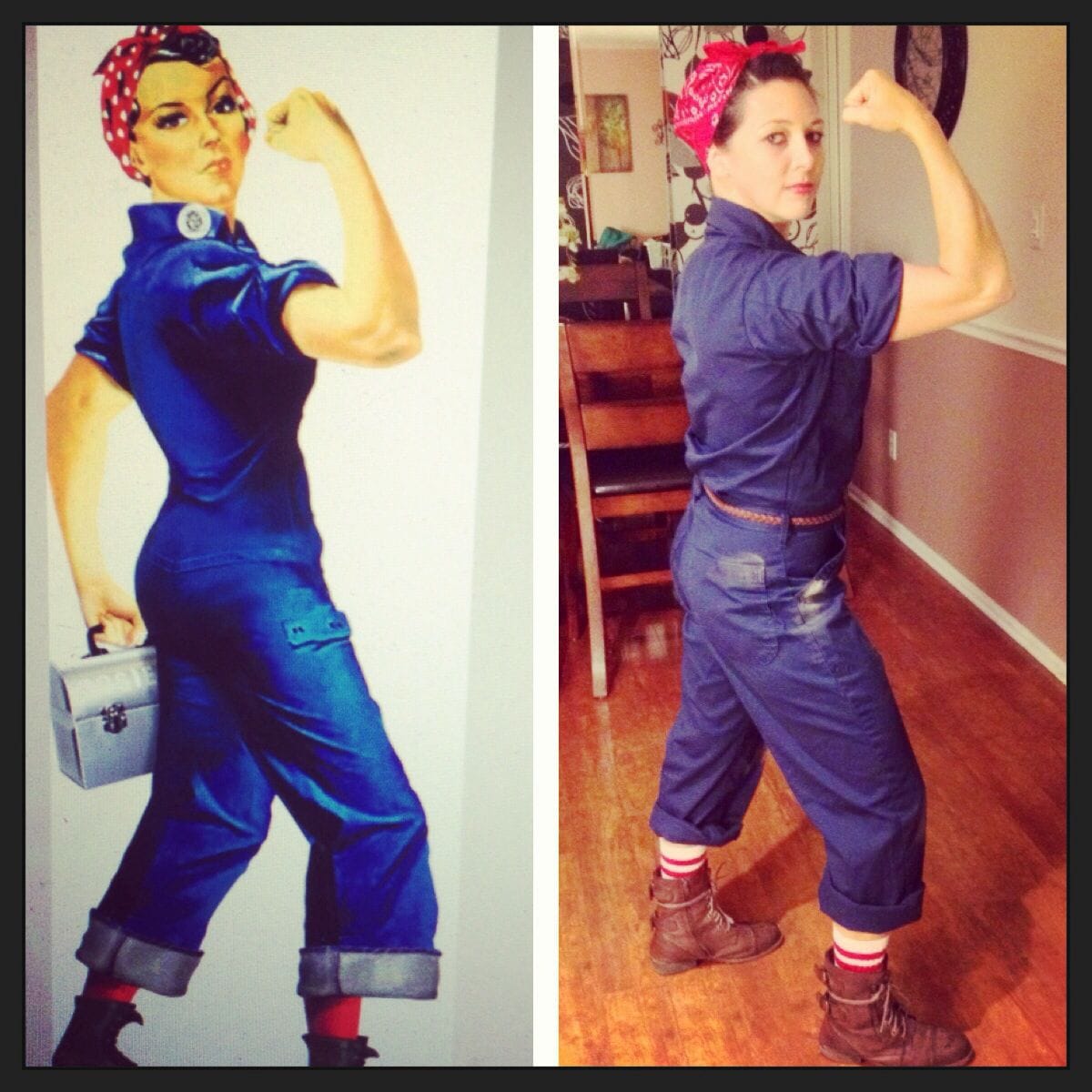Decoding Rosie’s Denim: The Real Story Behind the Riveter’s Outfit
Rosie the Riveter’s iconic look—denim workwear, red bandana, and sturdy boots—symbolized female empowerment during WWII, transcending its practical origins to become a cultural touchstone. This ensemble isn’t just clothing; it’s a statement. It’s a nod to a powerful moment in history, a tribute to the women who stepped up when their country needed them most. Rosie, immortalized in the “We Can Do It!” poster, wasn’t a single person but embodied the spirit of millions of women who entered the workforce during World War II, taking on jobs traditionally held by men. Their contributions were vital to the war effort, proving that women could handle anything thrown their way. Let’s dive into how you can capture the essence of Rosie the Riveter and what her iconic look truly represents.
From Humble Beginnings to a Symbol of Strength
The core of Rosie’s look is undeniably practical, reflecting the nature of the work these women undertook. The denim jumpsuit (or high-waisted work pants and a chambray shirt) and sturdy footwear were essential for the demanding factory and shipyard environments. The red bandana with the white polka dots, arguably the most recognizable element, initially served the practical purpose of keeping hair out of machinery but quickly evolved into a symbol of defiance and a splash of color amidst the uniform industrial landscape. This blend of practicality and style captured the spirit of Rosie: strong, capable, and undeniably female.
Rosie for Everyone: A Symbol Reimagined
What’s fascinating about the Rosie the Riveter image is how it continues to evolve and inspire. It’s no longer solely tied to its World War II origins. Rosie-inspired outfits are now available for everyone—kids, adults, even pets. This widespread adoption speaks volumes about the enduring power and appeal of the image. Beyond its wartime origins, Rosie’s look has been embraced by feminist movements and reinterpreted in countless ways throughout popular culture. It’s become a symbol of female empowerment that transcends its historical context.
A Note on Respect and Cultural Sensitivity
While celebrating Rosie and what she represents is fantastic, it’s crucial to do so thoughtfully. If you don’t identify with the historical struggles of working women during WWII, be mindful of the outfit’s significance and wear it respectfully. It’s about appreciating the strength and contributions of these women, not trivializing their experiences.
Beyond the Bandana: A Deep Dive into Rosie the Riveter’s Workwear
So, we’ve talked about Rosie the Riveter, that powerful symbol of women’s strength during World War II. But what exactly did these amazing women wear? While the “We Can Do It!” poster cemented a single image, Rosie’s attire varied, reflecting the diverse women who filled vital wartime roles. More than just clothing, Rosie’s workwear represents the millions of women who challenged gender norms and contributed to the war effort on the home front. This attire isn’t just clothing, it is a story of practicality, breaking barriers, and a whole lot of strength.
The Core Components
The most famous image features Rosie in denim overalls or a jumpsuit—tough, durable, and ready for anything. Paired with a chambray work shirt, often with rolled-up sleeves, this attire reflects both practicality and an undeniable sense of style, capturing Rosie’s blend of strength and femininity. That iconic red bandana probably evolved from a practical need to keep hair out of machinery but quickly became so much more—a splash of color, a symbol of defiance, adding a touch of flair to the utilitarian workwear. Sturdy work boots or flats completed the ensemble.
A Diverse Reality
While the denim overalls and red bandana are the classic Rosie look, it’s important to remember that the reality was more diverse. “Rosie the Riveter” represented millions of women across various industries and roles. Some wore pants and work shirts for greater range of motion, while others in less physically demanding positions might have worn skirts. This variety reflects the breadth of women’s contributions to the war effort—welders, electricians, mechanics, and more, each with their specific clothing needs.
A Legacy of Empowerment
Rosie’s outfit is more than just clothes; it’s a symbol of a generation of women who stepped up, challenged expectations, and reshaped the American workforce. It represents their strength, determination, patriotism, and contributions to the war effort. Research continues to uncover the diverse experiences of these women, likely revealing even more about the challenges and triumphs of those who defied expectations. Rosie’s impact extends far beyond the clothes she wore—a legacy of empowerment that continues to inspire today.
Nailing the Rosie the Riveter Look: A Complete Guide to Her Iconic Style
So, you’re looking to channel your inner Rosie the Riveter? Excellent choice! This iconic figure represents strength, resilience, and a can-do attitude, and her look is surprisingly easy to assemble. Recreate Rosie’s powerful image with denim, a red bandana, and work boots, embodying the strength of women in wartime America. From overalls to jumpsuits, discover versatile options for your Rosie the Riveter ensemble, perfect for Halloween, historical events, or themed parties.
Rosie’s Signature Look: The Basics
The core of any Rosie outfit is simple and practical: a denim work shirt or jumpsuit, paired with the instantly recognizable red bandana with white polka dots, tied around your head with the knot at the top or slightly to the side. Sturdy work boots in brown or black complete the basic Rosie silhouette.
Mixing It Up: Rosie Outfit Alternatives
Don’t have a denim jumpsuit? No problem! Dark blue work pants or jeans are great alternatives. Coveralls, echoing factory attire, also work. High-waisted pleated pants can evoke the era. If you’re missing a denim top, a navy blue, plaid, or striped men’s button-down shirt, a knit pullover sweater, or a classic ringer t-shirt can work. The key is practical, comfortable, and vintage-inspired clothing.
Accessorizing and Makeup
Accessories elevate your Rosie look. Red lipstick adds a pop of color, echoing wartime makeup trends. A leather belt with pants or overalls adds ruggedness. Rolling up your sleeves showcases a ready-to-work attitude. A “We Can Do It!” poster makes a fantastic prop for photos.
Rosie on a Budget: DIY Costume Ideas
Thrift stores are treasure troves for vintage-inspired pieces, with affordable denim shirts, work pants, and even bandanas. You might even find an authentic vintage piece! Create your own headscarf or customize a t-shirt with iron-on patches. Consider searching online for vintage or reproduction clothing.
Rosie’s Modern Legacy
Incorporate Rosie’s style into your everyday wardrobe. A denim jacket with a Rosie-inspired t-shirt is a subtle nod; a casual dress with a red bandana tied around your head or wrist offers another option. Embrace the strength and empowerment she represents in your own unique way.
Rosie’s Message: Respect and Body Positivity
Remember, Rosie the Riveter isn’t just a costume; she’s a symbol. When you dress as Rosie, do so respectfully, appreciating the real women who stepped up during World War II. Rosie represents empowerment for all women, regardless of body type or background. Rock that Rosie outfit with pride and confidence!
| Item | Description | Alternatives |
|---|---|---|
| Top | Denim work shirt or jumpsuit | Navy, plaid, or striped button-down; knit sweater; ringer tee |
| Bottom | N/A if jumpsuit; otherwise, work pants or jeans | Coveralls, high-waisted pleated pants |
| Headwear | Red bandana with white polka dots | Self-made bandana |
| Footwear | Sturdy work boots (brown or black) | Flats or low heels |
| Accessories | Leather belt, rolled-up sleeves, “We Can Do It!” poster | |
| Makeup | Red lipstick |
Beyond the Bandana: Unpacking the Symbolism of the Rosie the Riveter Costume
We’ve talked about Rosie, but let’s delve deeper into what her image truly embodies. Donning a Rosie the Riveter costume isn’t just about the clothes; it’s about stepping into a powerful symbol of female strength, resilience, and history. The Rosie the Riveter costume embodies the strength and resilience of women who entered the workforce during WWII, challenging gender roles and contributing to the war effort. More than just denim and a bandana, the costume symbolizes female empowerment, patriotism, and the enduring legacy of women’s contributions to history.
A Symbol of Empowerment and Patriotism
Rosie’s iconic look – the denim work shirt, the red bandana, the flexed bicep – isn’t just a fashion statement. It’s a powerful visual shorthand for female empowerment and patriotism. It tells the story of women who broke barriers, challenged societal norms, and kept the country running during a national crisis. Their grit, determination, and unwavering commitment are embodied in this iconic image. Rosie’s iconic image transcended wartime propaganda, becoming a timeless symbol of female capability and a rallying cry for equal rights.
More Than Just Propaganda
Rosie’s image wasn’t just wartime propaganda; it transcended its original purpose. It became a timeless symbol of female capability, a rallying cry for equal rights, and a testament to the power of women working together. She represents the idea that women aren’t just capable, they’re essential. Dressing as Rosie the Riveter is a powerful act, connecting individuals to a pivotal moment in history and celebrating the ongoing fight for gender equality.
A Nuanced Reality
Some experts suggest that Rosie’s image may be oversimplified, even romanticized. The women who worked these demanding jobs faced long hours, difficult conditions, and often lower pay than their male counterparts. Ongoing research continues to explore the diverse experiences of women during this era, probably revealing even more about the challenges and triumphs of those who defied expectations. It’s important to acknowledge these complexities and recognize that Rosie, while a powerful symbol, doesn’t fully capture the entire spectrum of the female experience during World War II. The evolution of Rosie’s image, from initial depictions in overalls to the widely recognized bandana-clad figure, reveals a complex interplay of propaganda, commercial interests, and evolving social dynamics.
A Powerful Act of Remembrance
Putting on a Rosie costume connects us to this pivotal moment in history, honoring the “Rosies” who paved the way and celebrating the ongoing struggle for gender equality. It reminds us of how far we’ve come and how far we still have to go.
| Feature | Significance |
|---|---|
| Denim Shirt | Represents practicality, working-class identity, and breaking down traditional feminine attire. |
| Red Bandana | Initially practical, it became a symbol of femininity and style. |
| Flexed Bicep | Symbolizes strength, capability, and a “can-do” attitude, challenging stereotypes about women’s physical abilities. |
| Determined Look | Expresses focus, resilience, and a commitment to the task at hand. |
While Rosie’s image is deeply embedded in our cultural consciousness, it’s important to remember the human stories behind the symbol – mothers, daughters, sisters, friends, who stepped up when their country needed them. Dressing up as Rosie honors their contributions and ensures their stories continue to inspire.
- Unlock Water’s Symbolism: A Cross-Cultural Exploration - April 20, 2025
- Identify Black and White Snakes: Venomous or Harmless? - April 20, 2025
- Unlocking Potential: Origins High School’s NYC Story - April 20, 2025















